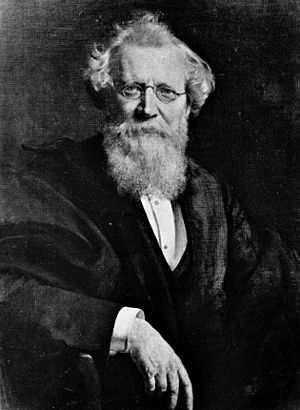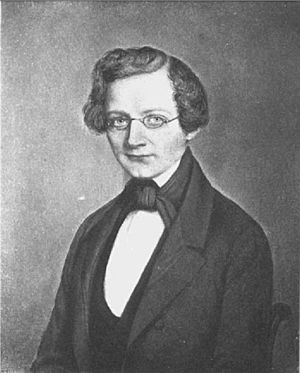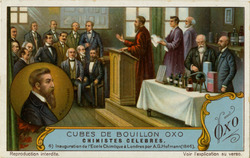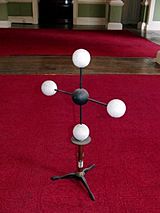August Wilhelm von Hofmann facts for kids
Quick facts for kids
August Wilhelm von Hofmann
|
|
|---|---|
 |
|
| Born | 8 April 1818 Giessen, Germany
|
| Died | 5 May 1892 (aged 74) Berlin, Germany
|
| Alma mater | University of Giessen |
| Known for |
|
| Spouse(s) |
|
| Awards |
|
| Scientific career | |
| Fields | Organic chemistry |
| Institutions |
|
| Doctoral advisor | Justus von Liebig |
| Doctoral students |
|
| Influenced | William Henry Perkin |
August Wilhelm von Hofmann (born April 8, 1818 – died May 5, 1892) was an important German chemist. He made many big discoveries in organic chemistry, which is the study of carbon-based compounds.
Hofmann's work on a chemical called aniline was very important. It helped create the first artificial dyes, which changed the fashion world. His research on coal tar also led to ways to get useful chemicals like benzene and toluene. These chemicals are used to make many things, including other dyes and medicines.
Some of Hofmann's own discoveries include formaldehyde, hydrazobenzene, and allyl alcohol. He also figured out how different amines (chemicals related to ammonia) are structured.
In 1845, Hofmann became the first leader of the Royal College of Chemistry in London, England. This college is now part of Imperial College London. Later, in 1865, he moved back to Germany to teach and research at the University of Berlin. When he returned, he helped start the German Chemical Society in 1867.
Hofmann received many important awards for his work. These included the Royal Medal in 1854 and the Copley Medal in 1875. He was also honored by being allowed to add "von" to his name, which was a special title.
Contents
Early Life and Chemistry Studies
August Wilhelm Hofmann was born in Giessen, Germany, on April 8, 1818. His father was an architect. As a young boy, August traveled a lot with his father.
He started studying law and languages at the University of Giessen in 1836. But his interest changed to chemistry around 1839. This happened when his father helped make the chemistry labs bigger for a famous chemist named Justus von Liebig.
Hofmann then studied chemistry with Liebig. He earned his PhD in 1841. In 1843, he became one of Liebig's assistants.
Hofmann's Career and Teaching
Leading the Royal College of Chemistry
In 1845, Albert, Prince Consort, who was married to Queen Victoria, wanted to improve science in Britain. He suggested starting a new school for practical chemistry in London. This school was called the Royal College of Chemistry.
Prince Albert asked Liebig for advice on who should lead the new school. Liebig recommended Hofmann. Hofmann became the first director of the college in 1845.
The college had a difficult start financially. But it became very successful and was a world leader in making aniline dyes. Many students who studied there went on to make important discoveries in chemistry.
In 1853, the Royal College of Chemistry became part of a government department. This helped it get more stable funding. Later, the college became part of Imperial College London. This was done to help Britain keep up with Germany in science and technology.
Returning to Berlin University
In 1864, Hofmann was offered important chemistry jobs at two German universities. He took his time to decide and even helped design new lab buildings for both universities.
In 1865, he chose to become a professor of chemistry at the University of Berlin. He also became the director of their chemical laboratory. He stayed in this job until he passed away in 1892.
After returning to Germany, Hofmann helped create the German Chemical Society in 1867. He was president of this society many times.
Important Discoveries and Contributions
Hofmann's work covered many different areas of organic chemistry.
Making New Chemicals (Organic Synthesis)
Hofmann was very good at developing ways to make new chemicals in the lab. This process is called organic synthesis. He and another chemist, John Blyth, were among the first to use the word "synthesis" in chemistry.
They used synthesis to understand how chemicals are put together. By making new substances, chemists could learn more about how different chemicals react and what they are made of. This method became a key part of Hofmann's research.
Coal Tar and Colorful Dyes
Hofmann's first research looked at chemicals found in coal tar. He found that many different substances that chemists thought were unique were actually the same chemical: aniline. Aniline is a nitrogen-containing compound.
Hofmann noticed that aniline was similar to ammonia. He showed that organic bases (chemicals that can accept protons) could be thought of as related to ammonia. He successfully changed ammonia into other chemicals like ethylamine. He was also the first to create quaternary amines, which are a special type of amine.
One of his famous discoveries is the Hofmann rearrangement. This is a way to change one type of chemical (an amide) into another (an amine). He also discovered the Hofmann elimination, which is a method to change quaternary amines into tertiary amines. He used this method to figure out the structure of coniine, a poison found in hemlock plants.
In 1848, Hofmann's student Charles Blachford Mansfield found a way to separate useful chemicals like benzene and toluene from coal tar. This was a big step for making products from coal tar.
A very important discovery happened in 1856. Hofmann's student William Henry Perkin accidentally discovered the first artificial aniline dye, called mauveine. This discovery led to many new colorful dyes that changed the textile industry and fashion.
Hofmann himself did a lot of research on dyes. He studied rosaniline and found that he could add different chemical groups to it to make dyes of various purple and violet colors. These became known as 'Hofmann's violets'.
Understanding Molecules with Models
Hofmann was probably the first person to use physical models to show how molecules are shaped. This happened after chemists started to understand the idea of chemical structure.
In 1865, he showed off his molecular models at a talk in London. He made them from different colored croquet balls connected by brass tubes. Each color represented a different atom:
- Black for carbon
- White for hydrogen
- Blue for nitrogen
- Red for oxygen
- Green for chlorine
- Yellow for sulphur
This color scheme is still used today in a similar way, called the CPK coloring scheme. These models helped chemists understand that molecules are three-dimensional.
The Hofmann Voltameter
In 1866, August Wilhelm von Hofmann invented a device called the Hofmann voltameter. This tool is used to split water into its basic elements: hydrogen and oxygen. This process is called electrolyzing water.
The voltameter has three glass tubes joined together. You add water and a little bit of something like sulphuric acid to help electricity flow. When an electric current passes through, oxygen gas collects in one tube and hydrogen gas collects in the other. You can see that there's twice as much hydrogen as oxygen, showing water is H₂O.
Awards and Special Honors
Hofmann received many awards for his important work. He became a fellow of the Royal Society in 1851. He won the society's Royal Medal in 1854 and the Copley Medal in 1875. The Copley Medal was given to him for his many contributions to chemistry, especially his research on chemicals related to ammonia.
On his 70th birthday in 1888, he was given a special honor. He was "ennobled," which meant he could add "von" before his last name. This was a sign of great respect.
In 1900, the German Chemical Society built a building called "Hofmann-Haus" in Berlin. In 1902, they created the August Wilhelm von Hofmann Gold Medal in his honor. This medal is given for amazing achievements in chemistry.
Later Life
Hofmann passed away in 1892. He was buried in Berlin, Germany.
See also
 In Spanish: August Wilhelm von Hofmann para niños
In Spanish: August Wilhelm von Hofmann para niños
- History of the molecule
- Timeline of hydrogen technologies
Sources
- Bericht über die Entwickelung der chemischen Industrie während des letzten Jahrzehns : im Verein mit Freunden und Fachgenossen erstattet . Volume 1–3.1, Vieweg, Braunschweig 1875 – 1877 Digital edition by the University and State Library Düsseldorf





